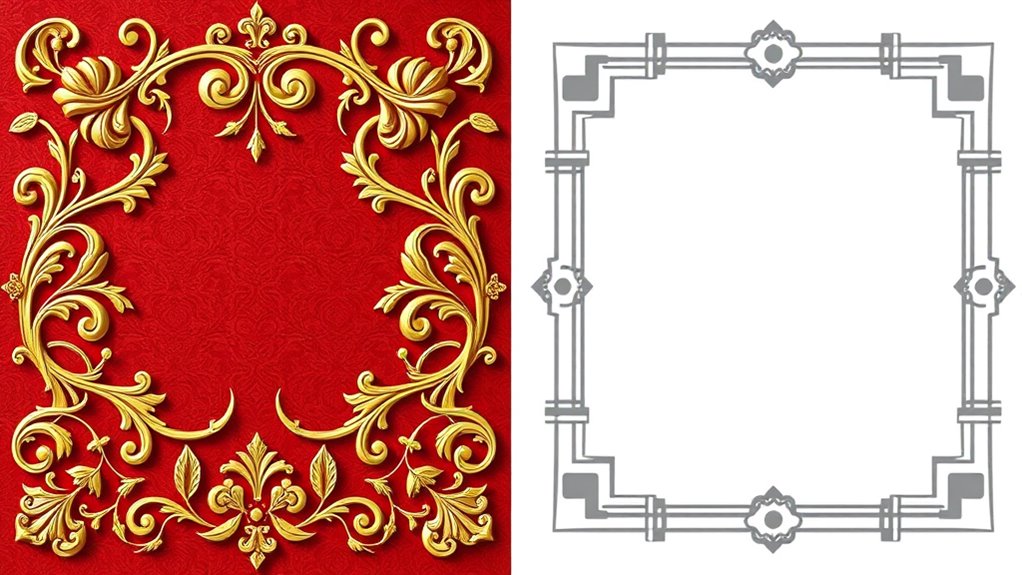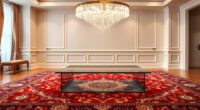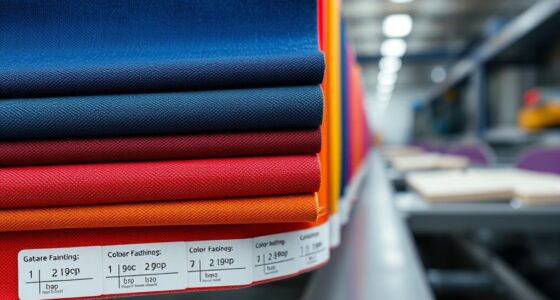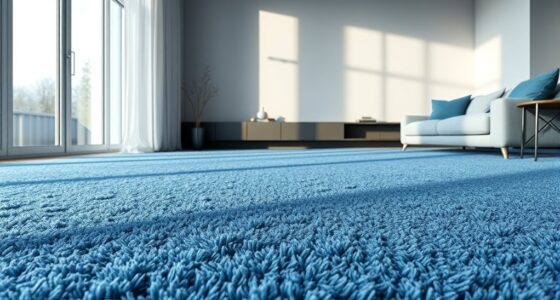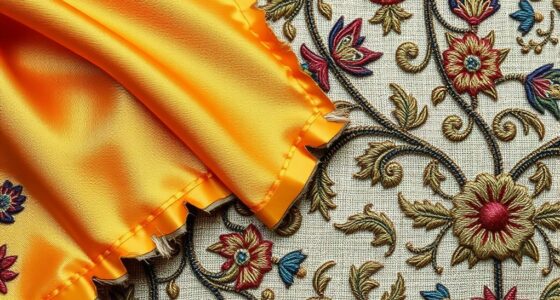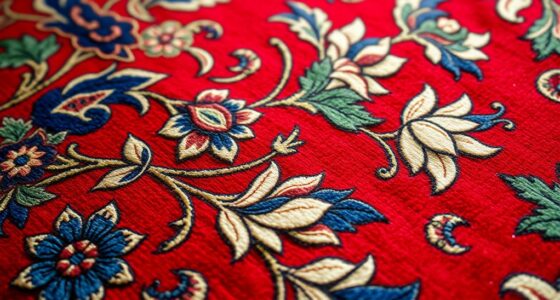Classic border designs have historic roots, rich with intricate motifs inspired by cultural symbols, using traditional materials like silk, cotton, or wool and techniques like embroidery or weaving. Contemporary styles favor minimalism, bold patterns, and modern printing methods with vibrant colors and sleek lines. If you’re curious about how these styles differ in origins, materials, and uses, exploring further will reveal how each can perfect your space’s aesthetic.
Key Takeaways
- Classic borders feature intricate, symbolic motifs rooted in historical and cultural traditions, while contemporary borders emphasize minimalist, clean lines and geometric shapes.
- Traditional materials like silk, cotton, and embroidery techniques define classic designs, whereas modern borders often utilize digital printing on various fabrics.
- Classic borders reflect cultural heritage and storytelling; modern borders focus on simplicity, elegance, and visual harmony with contemporary aesthetics.
- Classic borders suit formal or traditional settings; modern borders are ideal for casual, modern, or minimalist spaces.
- Trends in classic borders emphasize craftsmanship and symbolism, while contemporary styles prioritize sleekness, bold colors, and streamlined patterns.
Origins and Historical Contexts
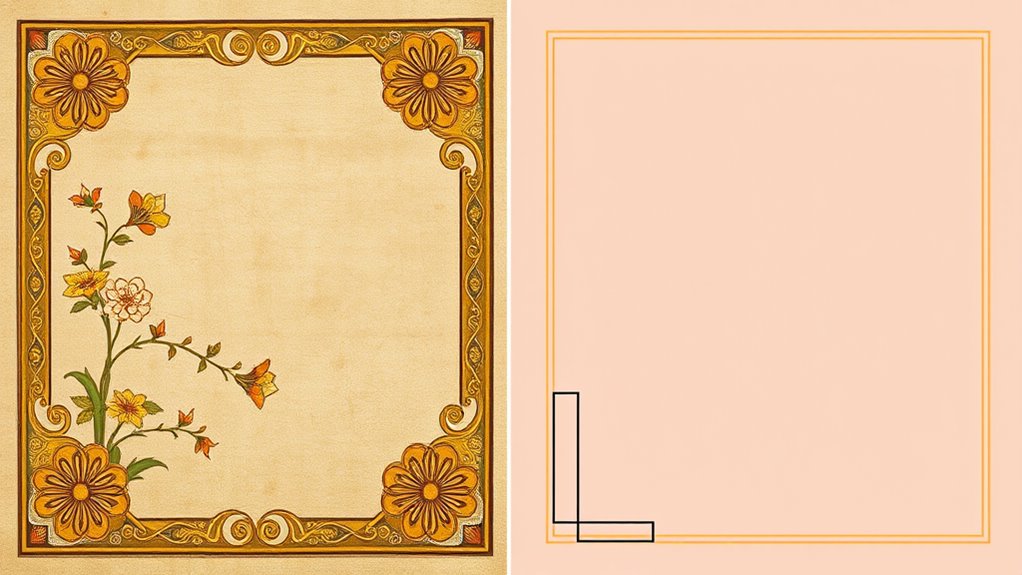
The origins of border design styles are deeply rooted in cultural exchanges and historical traditions that date back centuries. Ancient origins reveal how early civilizations used borders to mark boundaries and convey cultural symbolism. These designs often reflected societal values, spiritual beliefs, and identity, serving both decorative and functional purposes. For example, intricate patterns in Egyptian or Chinese art symbolized protection, prosperity, or spiritual concepts. Over time, these motifs spread and evolved, influenced by trade, conquest, and intercultural contact. Recognizing the historical context helps you appreciate how borders are more than mere decoration—they embody a rich tapestry of cultural symbolism and identity that has been passed down through generations. Additionally, understanding the importance of cultural preservation highlights how traditional designs continue to influence contemporary art and craft practices. The preservation of these traditional motifs plays a vital role in maintaining cultural continuity and honoring ancestral craftsmanship, which shapes the diverse styles you see today and underscores the significance of maintaining cultural continuity. Moreover, the legacy of historical influences demonstrates how these designs have adapted over time while retaining their core symbolic meanings. It is also noteworthy that intercultural contact has significantly contributed to the diversity of border styles observed across different regions.
Key Visual Characteristics
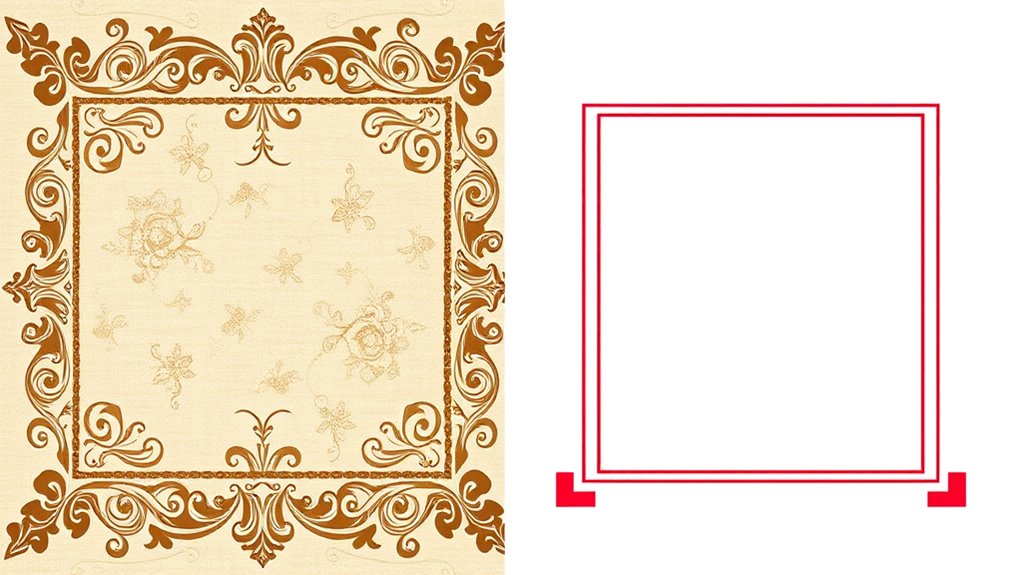
You’ll notice that traditional motifs and patterns often feature intricate details and cultural symbolism, giving borders a sense of history and identity. Modern minimalist elements, on the other hand, emphasize clean lines and simplicity, creating a sleek, understated look. Recognizing these visual characteristics helps you appreciate how borders can convey both heritage and contemporary style.
Traditional Motifs and Patterns
Traditional motifs and patterns in border design often feature intricate geometric shapes, floral elements, and symbolic imagery that reflect cultural heritage. These designs incorporate folk symbolism, representing beliefs, stories, or values specific to a region. Regional variations influence motifs, so patterns in one area may differ markedly from another, highlighting local traditions. You’ll notice repeated geometric patterns or floral motifs that carry meaning, such as protection or fertility. Understanding these symbols helps you appreciate the cultural significance behind each design. For example, recognizing regional influences can deepen your appreciation for the diversity and history embedded in traditional borders. Additionally, the use of color schemes often varies based on regional artistic traditions, further emphasizing local identity. Exploring traditional motifs reveals how deeply intertwined art and cultural identity are across different societies. Recognizing cultural symbolism within these designs can provide insight into the values and beliefs of the communities that created them. Moreover, traditional patterns often incorporate historical context, which enhances their significance and storytelling. Below is a table showing common motifs and their regional influences:
| Motif | Regional Variations |
|---|---|
| Geometric Shapes | Middle Eastern, Central Asian |
| Floral Elements | Indian, Mediterranean |
| Symbolic Imagery | Native American, Asian |
| Folk Symbolism | Eastern Europe, Africa |
| Traditional Patterns | South American, Balkan |
Modern Minimalist Elements
Modern minimalist border designs emphasize clean lines, simple shapes, and limited color palettes to create a sleek, unobtrusive aesthetic. You’ll notice geometric simplicity dominates these designs, with borders often featuring straightforward patterns like lines, circles, or rectangles. These shapes are arranged with precision, avoiding clutter and unnecessary ornamentation. The color palette is carefully chosen, typically sticking to neutral tones or a few accent colors to maintain visual harmony. This restraint allows the border to complement your content without overpowering it. Additionally, the use of natural materials can subtly enhance the understated elegance of minimalist borders. Incorporating sound healing science principles, such as subtle vibrations, can inspire designs that evoke calm and balance. The focus is on clarity and elegance, making your design feel modern and sophisticated. By prioritizing simplicity and geometric forms, you achieve a balanced look that enhances your overall visual presentation while keeping distractions at bay. Understanding visual hierarchy is essential to ensure that the borders support rather than compete with the main content. Applying interior design principles can further elevate the cohesiveness of your overall aesthetic. Paying attention to material choices can influence how light interacts with your borders, adding to their subtle appeal.
Common Materials and Techniques
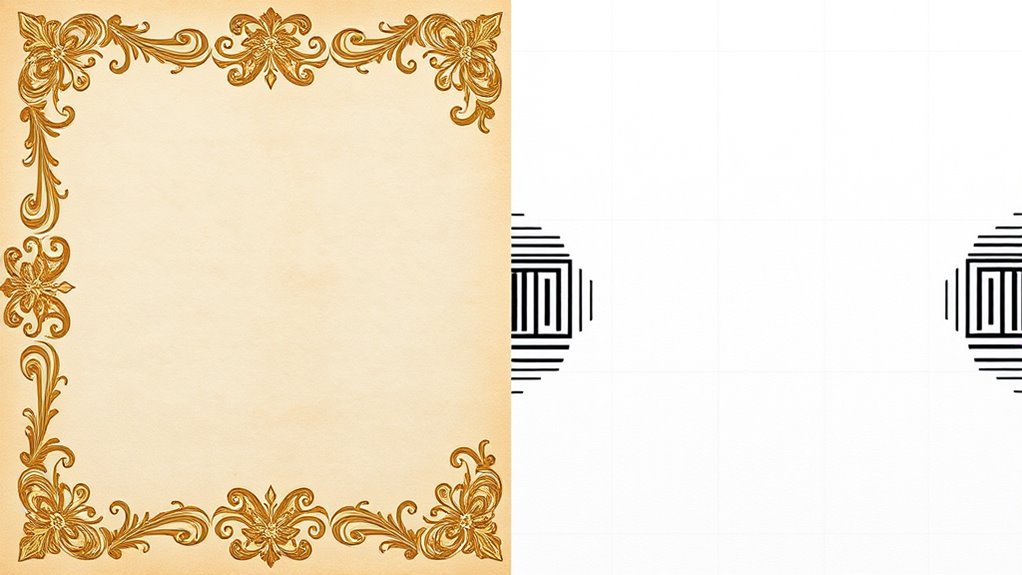
You’ll see that traditional embroidery methods often use fabrics like silk or cotton, creating rich textures and intricate details. Modern printing techniques, on the other hand, allow you to quickly produce bold and colorful designs on various materials. Understanding these materials and techniques helps you choose the right border style for your project. Incorporating quality assurance practices into your process ensures consistent results and durability of the border designs. Additionally, advancements in AI-powered design tools are beginning to influence how intricate border patterns are created and customized. Staying aware of cybersecurity concerns, such as email security, can help protect your design files and digital assets from theft or tampering.
Traditional Embroidery Methods
Embroidery methods have been passed down through generations, utilizing a variety of materials that enhance both durability and beauty. You’ll notice traditional techniques often involve intricate weaving techniques that create detailed patterns and textures. Additionally, color symbolism plays a crucial role, with specific hues conveying meanings like prosperity, health, or spirituality. Different embroidery styles, such as cross-stitch or satin stitch, reflect regional customs and cultural values. To deepen your understanding, consider this table showcasing common materials and their significance:
| Material | Technique Used | Symbolic Meaning |
|---|---|---|
| Silk | Satin stitch | Wealth and elegance |
| Cotton | Crewel embroidery | Purity and simplicity |
| Wool | Chenille work | Warmth and protection |
| Metallic threads | Couching | Power and prestige |
| Natural dyes | Hand dyeing | Nature’s vitality |
Modern Printing Techniques
Modern printing techniques utilize a variety of materials and methods to create vibrant and durable designs. Digital printing stands out for its precision and ability to reproduce intricate border patterns quickly, making it popular for customized projects. Textile innovation has expanded the possibilities, allowing you to print directly onto fabrics like silk, cotton, or synthetic blends. These methods enable bold colors, sharp details, and seamless integration with fabric textures. You can experiment with different finishes such as matte or gloss to enhance the visual effect. Modern printing also reduces production time and waste compared to traditional methods, making it cost-effective for small runs. Whether for decorative borders or elaborate designs, digital printing and textile innovation give you the flexibility to achieve contemporary, eye-catching results efficiently.
Cultural Influences and Inspirations

Cultural influences and inspirations play an essential role in shaping border design styles, reflecting the rich traditions and artistic expressions of different communities. Folk art often serves as a foundation, bringing vibrant patterns and motifs that convey cultural stories and values. Regional symbolism also plays a vital part, as specific symbols represent local beliefs, history, or nature. When you examine traditional borders, you’ll notice how these elements are woven into intricate designs that honor heritage. These influences give borders authenticity and depth, making them more than mere decoration—they become a visual narrative of a community’s identity. Whether inspired by indigenous craft or regional legends, cultural influences guarantee that border designs remain meaningful and rooted in tradition.
Suitable Settings and Uses
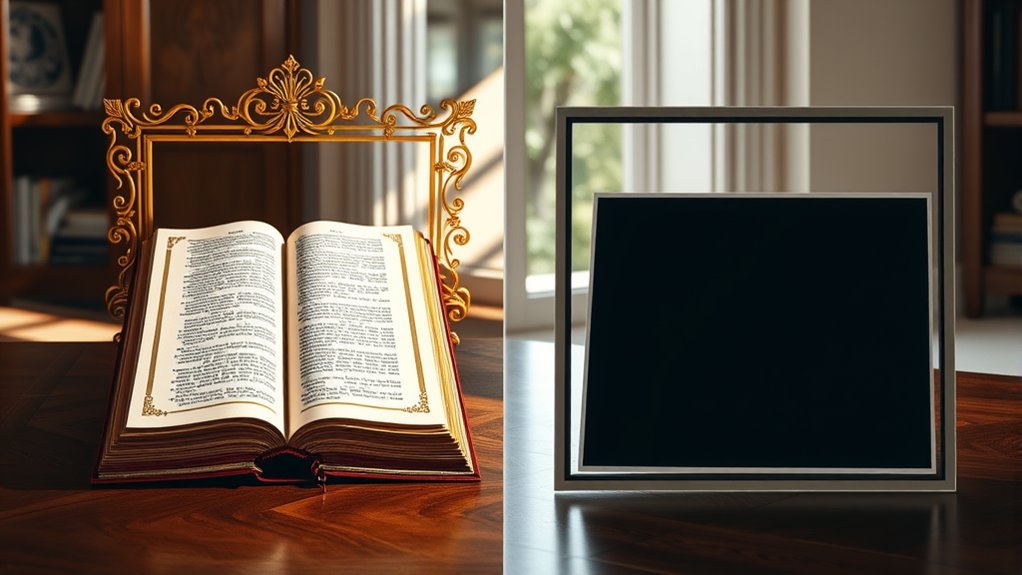
Have you ever wondered where border designs work best? The answer depends on the color schemes and suitable settings you choose. Classic borders often suit formal environments like traditional homes, offices, or historic buildings, where rich, muted tones enhance elegance. They add a timeless touch without overwhelming the space. Contemporary borders, on the other hand, thrive in casual or modern settings such as cafes, art galleries, or trendy offices. They typically feature bold or vibrant color schemes that create visual interest. Use traditional borders to frame artwork or accentuate architectural details, while modern styles work well as statement pieces or around contemporary furniture. Matching the border style to your setting ensures it complements the overall aesthetic and creates a cohesive look.
Tips for Incorporating Each Style

To successfully incorporate border designs into your space, start by considering the overall style and atmosphere you want to achieve. For a cohesive look, focus on color coordination; choose border colors that complement your walls, furniture, and accents. When mixing patterns, keep it simple—pair subtle, classic borders with bold, contemporary ones to create visual interest without overwhelming the space. Balance is key: if your border has intricate details, keep other design elements minimal. Conversely, for modern, streamlined borders, feel free to experiment with contrasting patterns or textures. Always step back and assess how the border interacts with the rest of your decor, ensuring it enhances rather than clashes with your overall aesthetic. This approach helps you create a harmonious and stylish environment.
Trends and Future Directions

Are border design styles evolving to meet modern aesthetic demands? Absolutely. The stylistic evolution reflects a blend of traditional craftsmanship with innovative adaptations, creating fresh and versatile options. Trends point toward minimalistic borders that emphasize clean lines, while digital tools enable intricate, customizable patterns. Future directions include interactive borders for digital interfaces and eco-friendly materials for physical applications. You’ll see a rise in sustainable designs, integrating nature-inspired motifs with modern aesthetics. The ongoing innovation guarantees borders remain relevant, adaptable, and visually compelling, appealing to diverse tastes. As designers continue to push boundaries, expect a seamless integration of classic elegance with contemporary flair. This evolution promises exciting possibilities, making border designs more dynamic, personalized, and aligned with current and future design needs.
Frequently Asked Questions
How Do Border Designs Influence Room Ambiance?
Border designs considerably influence your room’s ambiance by creating focal point accents that draw the eye and set the mood. They can add a touch of elegance or modern flair, depending on the style. You’ll find that thoughtful border choices enhance stylistic integration, making your decor feel cohesive. Whether subtle or bold, borders help you personalize your space and evoke the atmosphere you desire, transforming your room into a truly inviting environment.
Can Mixed Border Styles Create Visual Harmony?
When it comes to mixing border styles, you might find that it’s a case of “fitting the pieces together.” Combining floral patterns with geometric motifs can create visual harmony if you balance colors and scale thoughtfully. The key is to make certain the styles complement rather than clash, so your space feels unified. With some careful planning, you can turn contrasting borders into a charming, cohesive design feature that elevates your room.
Are There Specific Colors Best Suited for Each Style?
When choosing colors for your borders, consider the color palettes that match your design themes. For classic styles, you might favor muted, elegant tones like gold, navy, or burgundy that evoke tradition. Contemporary borders often thrive with bold, vibrant colors such as teal, lime, or monochrome shades. Selecting colors that complement your overall decor enhances harmony. Remember, contrasting tones can create visual interest, but balance is key for a cohesive look.
How Do Border Sizes Impact Overall Design Balance?
You might think that border sizes don’t matter, but they actually play a vital role in design balance. Thicker borders can create a bold statement, framing your piece prominently, while thinner borders maintain subtlety. Border thickness influences how your border pattern choices complement the overall look. Experiment with different sizes to find the perfect balance, ensuring your design feels harmonious rather than overwhelming or underwhelming.
What Maintenance Is Required for Different Border Materials?
When choosing border material choices, you need to consider maintenance tips to keep them looking their best. For wood borders, regularly clean and seal to prevent damage from moisture. Tile borders require occasional grout cleaning and resealing. Vinyl borders are low-maintenance, needing just a wipe-down. Stone borders might need sealing every few years. Understanding these maintenance tips helps you preserve your border’s appearance and durability over time.
Conclusion
Think of classic and contemporary borders as two travelers on a journey. One carries the weight of history, rich with tradition, while the other dances freely with modern ideas. Together, they create a tapestry that tells your story. By choosing the right style, you become the artist steering this voyage, blending the old with the new. Embrace their voyage, and let your space be a vibrant map of your unique journey through time and style.
